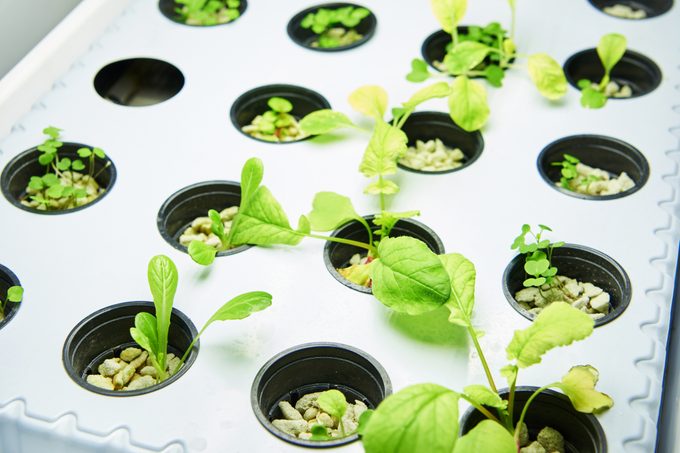Humans have relied on cultivating plants for at least 12,000 years. But these days, growing indoor plants is getting downright trendy, thanks in part to our windowsill companions and mainly our growing desire for food independence.
Scientists are proving that bringing these splashes of green nature inside our homes lightens our moods and lowers our stress. But as the seasons change and the days grow shorter, sometimes our leafy buddies also need a little boost. Enter grow lights.
“With the resurgence of indoor plant popularity, many plant enthusiasts have discovered their favorite plants may not thrive in their low-light conditions,” says Leslie F. Halleck, an author and certified professional horticulturist. “Or they want to grow seedlings and edibles indoors, which pretty much always requires grow lighting.”
What Is a Grow Light?
Grow lights supplement part or all of the natural sunlight plants need to photosynthesize. Grow lights can help for many tasks, like growing a year-round kitchen herb garden, overwintering potted plants or starting garden seedlings in the spring.
“You don’t need a green thumb to start gardening indoors with grow lights,” says Halleck. “You just need a desire to learn and willingness to make a few mistakes. Green thumbs are, after all, earned not born!
“That said, it’s beneficial to at least dip your toes into learning a bit more about light science, how plants use lights, and how measuring light indoors can significantly change your understanding of how to use grow lights successfully.”
Can a Regular Light Bulb Help Plants Grow?
Maybe, depending on the type. Plants do best with light wavelengths in the blue and red spectrums. Regular incandescent light bulbs fall more heavily in the less-helpful yellow and green spectrums. They also give off a lot of heat, which will damage plants when placed close enough to receive enough meaningful light.
On the other hand, regular fluorescent and LED bulbs can be adequate in some situations, as their white light incorporates a combination of many wavelengths. However, they are not as effective as grow lights specifically designed to deliver more intensity, with a proper color balance.
“We pay for every photon that we generate in terms of our electricity, so we should ideally want to only pay for photons that get used, as opposed to yellow ones that would be used by the plant less efficiently,” says Jonathan Ebba, a field specialist with the University of New Hampshire Cooperative Extension.
Why Are Grow Lights Effective?
Grow lights help plants photosynthesize. That allows them to survive and even flourish in winter, by turning the season’s short days into more summertime-like conditions.
Grow lights are only effective if their intensity is strong enough for each plant’s particular needs. Spending the time to research what lamp to buy based on what you intend to grow will greatly increase your chances of success.
“There’s so much junk [being marketed] right now,” Ebba says. “LED technology is new and kind of sexy, so suddenly we can buy tons of grow lights with a pink and purple shine, but many of them are so weak they can’t really accomplish anything, except maybe they can help a low-light houseplant on a windowsill grow better.”

Which Plants Respond Best To Grow Lights?
Generally speaking, the more sunlight a plant requires, the more it will benefit from a grow light. Plants that naturally grow below a rainforest tree canopy usually require less light, while plants from the Mojave Desert want a lot of light.
Plants that benefit greatly from a grow light include:
- Tomatoes and other fruiting-bearing plants;
- Herbs and other edible plants;
- Flowering plants;
- Aloe, cacti and other succulents;
- Sago palm;
- Seedlings.
“Stretched, leggy, thin, weak-looking plants indicate a plant is not getting enough light,” says Ebba.
Plants that may do fine with a low-power grow light or no grow light, especially if they get some decent natural windowsill exposure, include:
- Ferns;
- Bromeliads;
- Philodendron;
- Spider plants;
- Bird of paradise.
“The best way to be successful with a grow light is to first learn more about the species of plant or crop you are growing,” says Halleck. “Each species has a requirement for the intensity and duration of light it would normally get from the sun in order to thrive and reproduce.
“When you acquire a deeper understanding of how tomato plants grow and the amount of light they actually need to thrive, it will completely change your perspective on the type of indoor grow light setup you’ll need to achieve those results.”
Article source here: How Are Grow Lights Different From Regular Light Bulbs?


No comments:
Post a Comment